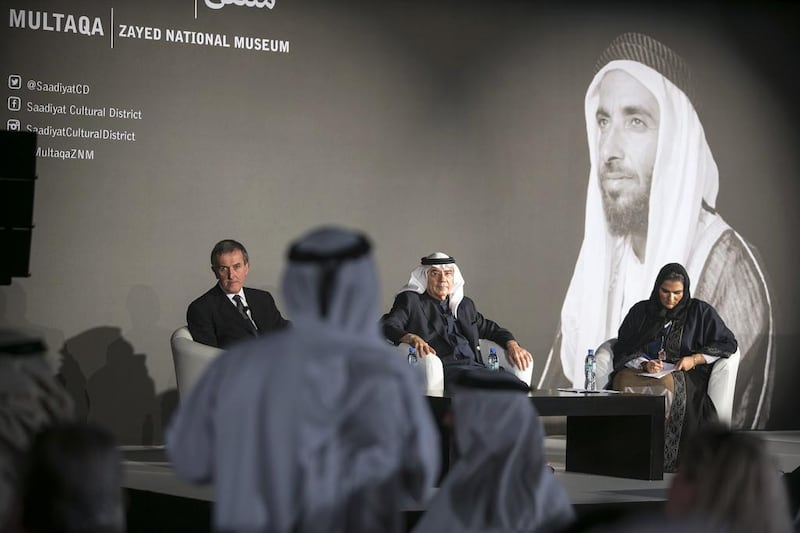ABU DHABI // Zayed National Museum will play a central role in furthering the UAE’s national identity.
That is according to speakers at the first of a series of public talks dedicated to the narrative and development of the museum.
The series, Multaqa (forum), began on Tuesday at Manarat Al Saadiyat with a talk entitled “National Museum, National Identity”, the first of five until May in Abu Dhabi city and Al Ain.
“The story of the UAE is one that should be told to citizens, residents, and visitors alike and will be beneficial to all,” said Zaki Nusseibeh, cultural adviser to the Ministry of Presidential Affairs.
Having served as a translator for Sheikh Zayed before the formation of the UAE, Mr Nusseibeh said the founding President was always confident of developing a prosperous country.
Sheikh Zayed’s legacy of strong leadership, vision, tolerance, sense of regional and international community would be reflected by future exhibitions at the the museum, he said.
“The museum will illustrate how far the UAE has developed into a financial, cultural and educational centre of the region,” said Mr Nusseibeh.
The museum, which will become the centrepiece of Saadiyat Cultural District, will tell the story of the UAE through exhibitions depicting the life and achievements of Sheikh Zayed.
It will have seven permanent gallery displays, which will include “Sheikh Zayed : Life and Times”, “Falconry and Conservation”, “Land and Water”, “People and Heritage”, “History and Society”, “Science and Learning” and “Faith and Islam”.
Neil MacGregor, director of the British Museum, said visitors would first walk through the Falconry and Conservation gallery, a garden surrounding the main structure that would tell the story of Sheikh Zayed’s love of the country’s landscape, falconry and their preservation.
Upon entering the museum, the first gallery visitors will see is an exhibition about the life of Sheikh Zayed.
“The idea is that any visitor will get a grasp and understanding of the history of the UAE through these galleries,” said Mr MacGregor.
The second section of the museum will focus on the UAE’s agriculture and its connection with the sea in the Land and Water display. Mr MacGregor said this exhibition would illustrate the UAE’s connection with the sea and the travellers who had landed on its shores, reinforcing the UAE’s maritime identity.
Answering the question about the narrative of the UAE and its people through the display of artefacts was essential in shaping the museum and its goal of reflecting and promoting the UAE’s national identity, said Mr MacGregor.
That was the same question that the curators of the British Museum asked when it was founded in the mid-18th century. The answer ensured that Britons understood that the museum belonged to them, along with free admission to the public and keeping close communications with them.
Despite sharing the core values of some national museums across the UAE, the Zayed National Museum will be a modern institution that uses not just artefacts to tell its story.
The UAE’s heritage will be on display through recordings of Emiratis of the past and present, as well as those whose lives were touched by Sheikh Zayed.
“UAE’s oral heritage is very important to our identity and it will be reflected in the museum,” said Mr Nusseibeh.
Salama Al Shamsi, the museum’s project manager, moderated last night’s talk. She said establishing a national museum in the UAE in the 21st century was vital to creating and maintaining a connection to the country’s past.
Dr Woodman Taylor, chairman of visual communication at the American University of Dubai, said: “This talk is important in highlighting the use of objects as cultural diplomacy and to increase the dialogue between different civilisations.”
talsubaihi@thenational.ae






